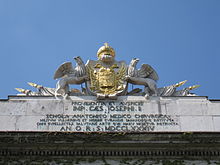Josephinum (Vienna)
The Josephinum also Collegium-Medico-Chirurgicum-Josephinum was a medical-surgical academy in Vienna for the training of military doctors for the Austrian army. Today the Institute for the History of Medicine of the Medical University of Vienna is housed in the buildings of the former Josephinum , as are other institutes.
history
The Josephinum was founded by Emperor Joseph II in 1784 as the Imperial and Royal Medical and Surgical Joseph's Academy for the training of doctors and surgeons for the army and opened on November 7, 1785. The initiative for this was taken by his personal surgeon Giovanni Alessandro Brambilla , whom the Emperor had entrusted in 1779 with the management of the entire Austrian military medical system, in which much had to be reformed. Brambilla served as director of the college until 1795. On February 3, 1786, the academy was put on an equal footing with all other faculties and received the right to graduate doctors and masters of medicine and wound medicine.
For the academy, a new building was built from 1783 to 1785 according to plans by Isidor Marcellus Amandus Canevale in what was then Alservorstadt , in today's 9th district of Vienna , at today's Währinger Strasse 25 . For this purpose, an old shooting range and an estate were bought and demolished. The building site was chosen with a view to the neighboring military garrison main hospital built in 1783/84 (later Garrison Hospital No. 1) on today's Van-Swieten-Gasse.
The art historian Hans Tietze wanted to recognize a mini-edition of the national library in the building . In the middle wing there is a large staircase with steps made of hard, white Kaiserstein from Kaisersteinbruch . The building marks the turn from Josephine baroque classicism to actual classicism .
The library was equipped with 6,000 volumes, and the emperor also had wax preparations made for 30,000 guilders for the attached anatomical-pathological museum, which are now a special attraction. There were also mineralogical, botanical and zoological collections. For the opening, Joseph II had a 40 ducat commemorative coin minted.
After the death of Joseph II, the academy received significantly less attention from the government. On the initiative of the director at the time, Johann Nepomuk Isfordink , the academy was placed on an equal footing with the universities of the Austrian Empire by Franz I on October 27, 1822 . After three years break, the lectures were resumed on November 6, 1824 until the abolition of the Academy on decision of 1849 Franz Joseph I. organized. It was reopened in 1854 as a training institute for field doctors with the rank of a military academy . In 1874 the academy was finally closed.
Today the Josephinum houses the Institute for the History of Medicine. In the front garden there is a statue of the goddess of medicine Hygieia , which was made from lead by Johann Martin Fischer in 1787 .
From February 2019 to spring 2021, the building is to be renovated by around 11 million euros. The original state from the 18th century is to be partially restored, for example by dismantling the historic nine-meter-high lecture hall.
Well-known professors at the Josephinum
- Ignaz Bischoff von Altenstern (1784–1850), military doctor, pathologist
- Giovanni von Brambilla (1728–1800), protosurgeon and first medical director of the Josephinum
- Johann Chiari (1817-1854), gynecologist
- Franz Chvostek (1835-1884)
- Johann Dreyer von der Iller (1803–1871), ophthalmologist
- Josef Engel (1816–1899), pathologist
- Karl Heidler von Egeregg (1809–1887), practical medicine
- Johann von Hubertus (1752–1828), surgery
- Johann Hunczovsky (1752-1798), professor
- Johann Isfordink von Kostnitz (1776–1841), surgeon, military doctor and from 1822 director of the Josephinum
- Friedrich Jäger von Jaxtthal (1784–1871), ophthalmologist
- Franz von Pitha (1810–1875), surgeon
- Joseph von Plenck (1735–1807), from 1785 professor of chemistry and botany
- Johann von Raimann (1780–1847)
- Johann Schmidt (1759–1809), surgeon and ophthalmologist from 1795
- Joseph Späth (1823-1896), gynecologist
- Carl Stellwag von Carion (1823–1904), ophthalmologist
Well-known graduates of the Josephinum

- Eduard Albert (1841–1900), surgeon and literary translator
- Franz Chvostek (1835–1884), later professor at the Josephinum
- Christoph Hartung (1779–1853), pioneer of homeopathy
- Anton Hayne (1786–1853), surgeon and veterinarian
- Johann von Hubertus (1752–1828), later professor at the Josephinum
- Joseph von Kerzl (1841–1919), long-time personal physician to Emperor Franz Joseph
- Florian Kratschmer von Forstburg (1843–1922), military doctor and hygienist
miscellaneous
The Josephinum adorned the back of the 50 Schilling note , issued on October 19, 1987.
literature
- Speech on the occasion of the reopening of the Josephs Academy of Medicine and Surgery ; November 6, 1824; Staats-Aerarial-Druckerey Vienna 1824.
- Alfred Wolf: Alsergrund Chronicle. From Roman times to the end of the monarchy. Vienna 1981.
- Helmut Wyklicky: The Josephinum: biography of a house; the medical and surgical Joseph Academy since 1785; the Institute for the History of Medicine since 1920 . Brandstätter, Vienna 1985. ISBN 3-85447-152-1 .
- Helmuth Furch: Kaiserstein in Viennese buildings, 300 examples . In communications from the Kaisersteinbruch Museum and Culture Association, No. 59, December 2000.
- Wikidata: Q48054836 : Martina Markovska: Josephinum and the Anatomical Wax Model Collection, Medical University of Vienna , 2015
Web links
Individual evidence
- ^ Felix Czeike (Ed.): Historisches Lexikon Wien . Volume 1, Kremayr & Scheriau, Vienna 1992, ISBN 3-218-00543-4 , p. 439.
- ^ Felix Czeike (Ed.): Historisches Lexikon Wien . Volume 3, Kremayr & Scheriau, Vienna 1994, ISBN 3-218-00545-0 , p. 389.
- ↑ diepresse.com: The Josephinum is awakened from its slumber . Article dated May 3, 2018, accessed May 3, 2018.
- ↑ Josephinum is supposed to age with renovation. In: orf.at . September 23, 2019, accessed September 23, 2019.
Coordinates: 48 ° 13 ′ 9 ″ N , 16 ° 21 ′ 22 ″ E


